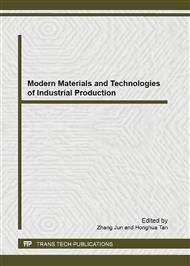p.171
p.177
p.181
p.186
p.192
p.196
p.200
p.205
p.213
Influence of Platinum on Electrical Propertires of Silicon Schottky Diode
Abstract:
The purpose of the paper is present the new result of electrical properties of Pt-doped silicon Schottky diodes that are fabricated by using CMOS technology. The results show the comparison of electrical properties namely current-voltage and capacitance characteristics between undoped and Pt-doped Schottky diode. The current characteristics of Pt-doped diode are decreased about 2 to 3 orders in term of reverse bias. As well as in case of forward bias, the current is slightly decreased. Schottky barrier height after Pt doping was increased from 0.84 eV to 0.86 eV. The built-in voltage of Pt-doped diodes was increased from 0.38 V to 0.42 V. The C-V characteristics after Pt doping is decreased about 5 pF. The change of electrical properties are caused by Pt because Pt atoms in silicon can occupy interstitial sites and change the trapping center. This paper will study and analyze the effect of Pt atom in silicon bulk of Schottky diode.
Info:
Periodical:
Pages:
192-195
Citation:
Online since:
September 2013
Price:
Сopyright:
© 2013 Trans Tech Publications Ltd. All Rights Reserved
Share:
Citation:


